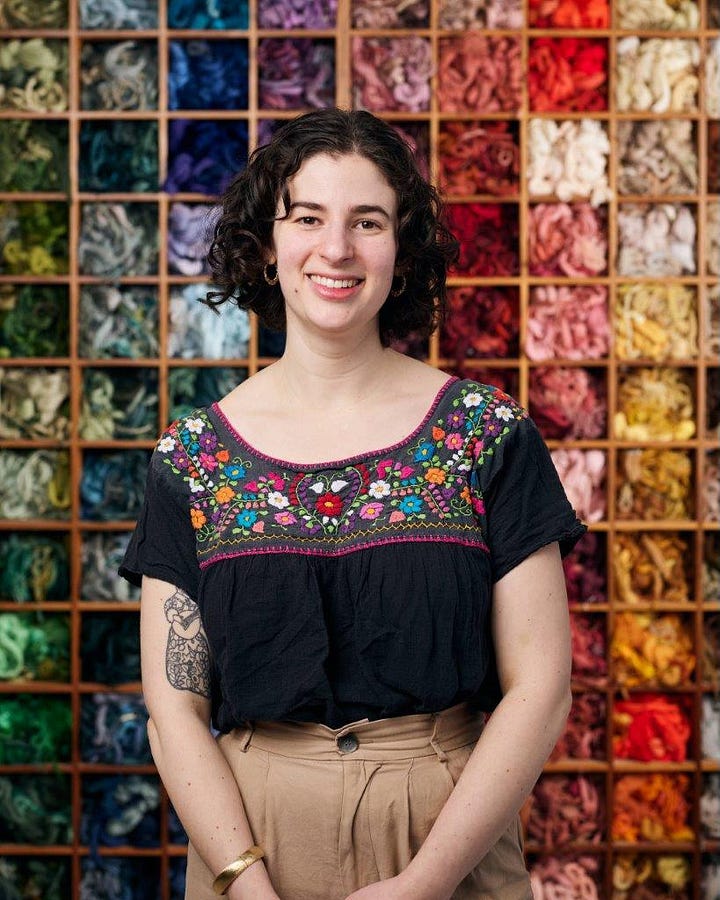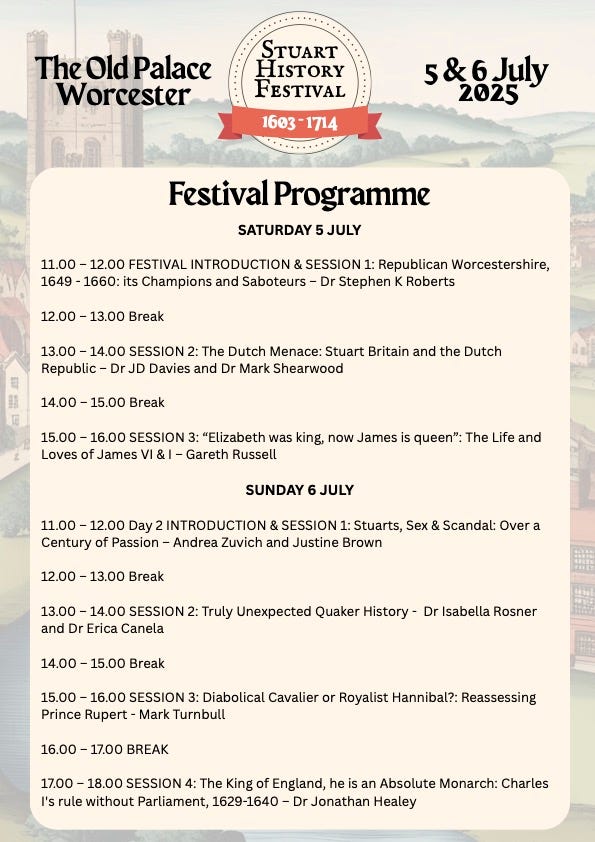What can a nutmeg can tell us about the Quakers?
Truly Unexpected Quaker History with Dr Isabella Rosner and Dr Erica Canela.
Hello fellow history lover!
Dr Isabella Rosner and Dr Erica Canela got together to answer my questions about the topic of their talk for the ‘Stuart History Festival’, this coming weekend, ‘Truly Unexpected Quaker History.’
Dr Isabella Rosner is the curator of textiles at the Royal School of Needlework and research consultant at Witney Antiques. She is a 2023 BBC/AHRC New Generation Thinker and author of Stitching Freedom: Embroidery and Incarceration (Common Threads Press). Isabella also hosts the successful Sew What? podcast about historical needlework and those who stitched it.
Dr Erica Canela is an Honorary Research Fellow in Philosophy, Theology, and Religion at the University of Birmingham. She is an early modern social historian specialising in English Quaker history and the psychological trauma of the Civil Wars. A recipient of several awards for her work in Quaker history, she holds a Ph.D. from the University of Birmingham and has taught early modern British history in both university and non-academic settings.


Who were ‘Quakers’ and what was different about the Quaker movement to other Christian belief systems?
Quakers, also known as the Religious Society of Friends, is a Christian movement that was, for all intents and purposes, founded by George Fox in 1647. Fox believed that the established churches were all corrupt and believed that people could connect directly to God and have this personal experience without the need for clergy or sacraments.
How did the name ‘Quaker’ come about?
The name came about as a result of the shaking or ‘quaking’ some attendees of Quaker meetings would experience when feeling the presence of God particularly strongly. It was originally intended as an insult, but the Religious Society of Friends took it on and proudly claimed it.
How would you summarise the common perception of Quakers?
When people think of Quakers in the 17th century, they normally think of pacifism and plain dress.
Was the reality very different from the perception and, if so, in what ways?
When it came to Quaker women’s and girls’ art making, the reality was and still is hugely different from the perception. I think the difference between the modern perception and the reality is the most striking, as modern Quakers expect Quaker women’s art of the past to always have been plain, simple, and unadorned. But actually, Quaker women’s art before the end of the 18th century was extremely decorative and flagrantly un-plain. It was oftentimes more decorative than the art being made by contemporary non-Quakers. I think people expect to see writing about this sort of art, everything from needlework to waxwork and shellwork, in early modern Quaker writings and disciplinary records, but they are conspicuously absent. Quakers are telling people that their aprons should be certain colours, their hoods a specific length, and their domestic furnishings free from fringe and colourful weaving, but there is almost no writing about how female Friends needed to avoid certain types of embroidery, thread colours, or techniques. There is next to no writing about domestic art or craft production at all.
Quaker women’s art before the end of the 18th century was extremely decorative and flagrantly un-plain.
Quakers also were not peaceful at the very start. At the onset, they would barge into churches, during services to antagonise the ministers and their congregations. As you would expect, this didn’t go down very well. They were known to communities as troublemakers - and in many cases, rightfully so. They engaged in disruptive behaviour that these days we would certainly call ‘antisocial’. Many of the leading early Quakers were also prolific writers and in the very early period they would quite openly write about their opponents spending eternity in a Lake of Fire. These opponents were naturally the local authorities who were arresting and imprisoning them but they saved their fiercest ire for the clergy. Quakers would engage in written disputes (pamphlet wars) with high-profile ministers. We are so fortunate that so many of these pamphlets have survived.
In your talk you are going to be busting some myths about 17th-century Quakers by telling some very interesting stories! Do you have a favourite one which you would pick out to share with us? And why did you pick it?
Isabella: My favourite story is actually an object, and that object is an embroidered nutmeg. Or rather, four embroidered nutmegs. A girl named Elizabeth Hall, who was from a mercantile Quaker family in Southwark, to the south of the City of London, attended Shacklewell School, the first official Quaker girls’ school. George Fox, the founder of Quakerism, established the school in 1668. While at that school in the early 1680s, Elizabeth Hall embroidered upon four nutmegs, using gold and silk threads, gold wire, and gold sequins (called spangles) to create covers for these spices. This is by itself a somewhat absurd and unnecessary show of skill and access to high-quality embroidery materials made more absurd by the fact that nutmegs were EXTREMELY expensive in the 17th century. They were worth more than their weight in gold, highly sought after for their use in cooking and medicines thought to protect against plague. It is shocking for a Quaker girl to render a single nutmeg useless by covering it with embroidery, but doing that for four nutmegs illustrates a wealth and conspicuous consumption that is nothing short of shocking. Elizabeth Hall’s nutmegs are beautiful and tiny reminders that early Quaker women’s art making stands in stark contrast to what we expect of this group of people and the objects they produced.
Erica: I love this story, too! I’ve been privileged enough to see a couple of these in person at an exhibition at Witney Antiques in 2023. They are indeed tiny and such gorgeous works of art. As a historian, I look at the grittier side of this early Quaker experience and I love that Isabella’s research exposes this incredibly beautiful and ostentatious side to the story. Truly unexpected Quaker history.
You can also find Isabella online at isabellarosner.com and on Instagram @historicembroidery
Find Erica online at ericanela.co.uk and on Instagram @ericanela
The Stuart History Festival Tickets
In Person
You can see Isabella and Erica’s talk at 1pm on Sunday 6th July at The Old Palace, Worcester. If you wish to attend in person please purchase your tickets in advance. Location: The Old Palace, Worcester, Worcestershire
Online
Great news! Wherever you are in the world you can attend the Stuart History Festival. An Online Pass is also available which allows you to watch live, and play back for a limited time, for just £45. Find out more by clicking the button below.
Festival Schedule
Visit https://www.tickettailor.com/events/thestuarthistoryfestival for full details and to purchase all tickets, day passes and the online pass.
Books and Book Signings
Event Speakers’s books will be available to buy at the festival but if you can’t make it, or are watching online you can buy them online and have them shipped anywhere in the world, at Blackwells, click on the banner below.
My Interview with the Organisers
Find out why the 17th Century is such a great topic for a festival of its own - and why we think it hasn’t already got one, in my interview with the festival’s organisers; Dr Erica Canela, Andrea Zuvich and Mark Turnbull.
Next time…
I’ll be talking to Mark Turnbull about Prince Rupert and why Mark thinks we need to take a closer look at this famous, but misunderstood, character of the Civil Wars.
See you soon!
Philippa 💜








What is the compelling point of this article? I seemed to have missed it.